
Research Article
Austin J Nutr Metab. 2019; 6(2): 1069.
Biological Evaluation of NaOH Treated and Un-Treated Feather Meal in Broiler Chicks
Naveed A, Sharif M* and Sultan JI
Institute of Animal and Dairy Sciences, University of Agriculture Faisalabad, Pakistan
*Corresponding author: Muhammad Sharif, Institute of Animal and Dairy Sciences, University of Agriculture Faisalabad, Pakistan
Received: October 03, 2019; Accepted: November 12, 2019; Published: November 19, 2019
Abstract
There is tremendous increase for broiler meat consumption in the country. There is need to use non-conventional feed resources in poultry diet to tackle the gap between nutrient demand and supply especially in the developing countries. A research trial was planned for biological evaluation of NaOH treated and untreated feather meal in broiler chicks. Four different rations (A, B, C and D) were formulated where A was nitrogen free, B was casein based while C and D consist of treated and untreated feather meal respectively. All the rations were iso-caloric (3100 Kcal/kg) and iso-nitrogenous (crude protein 10%) except ration A that was nitrogen free. The feather meal was processed using NaOH before its inclusion in the diet. Commercial ration was offered for 1st week to 80 dayold Hubbard chicks distributed to 20 experimental units. It was observed that values for feed intake, weight gain, protein efficiency ratio, net protein ratio and net protein utilization was significantly higher in birds feeding on casein-based ration followed by treated and untreated feather meal supplemented treatments. Feed conversion ratio was also significantly improved in birds fed with ration B as compared to others. It could be stated that the feather meal can be included in the broilers diet without any negative effect on its performance.
Keywords: Feather Meal; NaOH Treatment; Broiler; Biological Evaluation
Introduction
The Feather Meal (FM), a by-product of the poultry industry, is high in crude protein (approximately 85%). Birds consist of a considerable fraction of the feathers. At 3rd week of age, feathers represent about 4% of the body weight and at 7th week of age this figure becomes 7% of the BW. This means that birds produce a tremendous amount of feathers which if used as meal yields good proportion of protein otherwise it goes waste [1,2].
Poultry byproduct and hydrolyzed feather meal are the products resulting from the rendering of all the byproducts of poultry eviscerating plant. Feather meal is a good source of protein but its utilization in the poultry ration is restricted because of its poor nutritional value. Poultry by product meal contains feathers, blood and viscera at a ratio of approximately 40:40:20 respectively [3]. However, the feather meal is different from poultry byproduct meal in the sense that it consists purely of feathers. Hydrolyzed feather meal is the term used for the feather meal processed in a way to make its nutrients available which otherwise is not considerably utilized by the bird [4].
Sodium hydroxide treatment is proved to be a more rapid means of separating feathers from the carcass [5,6]. It also increases solubility and pepsin digestibility of FM. Moreover, the nutritive value of NaOH treated FM is quite better than untreated or enzyme treated FM. Besides it is much cheaper and makes the processing easy as well as it makes the good use of dead birds instead of throwing them away.
Protein content of poultry feed is major cost determining factor. The best protein source used so far is mostly the soybean meal. However, the cost of the feed can be reduced if some alternative protein sources are used. Traditionally protein needs of poultry ration are met mainly with vegetable proteins plus little amount of animal protein [7]. Although FM has high Crude Protein (CP) content but its nutritional value is low due to its keratin content [8] compared to other protein sources because keratin is poorly digestible. In this scenario NaOH treatment can play an important role to improve the nutritional value of FM. In addition it is a cost effective method for FM preparation [3].
At the present time, quality of FM is described only by its solubility in 0.2% pepsin solution [9]. Protein in FM must be at least 75% soluble, using the in vitro test. A more dilute solution (0.002% pepsin) has been tested as a way to more accurately differentiate among the qualities of FM [10]. Processing conditions affect the quality of FM. At low steam pressure, long hydrolysis times are needed to increase FM density and to improve digestibility [11,12]. At high pressures, there is a concern that bumping would occur [11]. Excessively processed FM has a decreased concentration of amino acids [13]. Keeping in view the above facts it is more beneficial to prepare FM by using NaOH treatment. As little information is known regarding the biological evaluation of NaOH treated FM so the present study is planned to assess the biological evaluation (protein efficiency ratio, net protein retention and net protein utilization) of NaOH treated FM.
Materials and Methods
The experiment was undertaken to determine the biological evaluation of NaOH treated feather meal in broiler chicks. The study was approved by the Institutional Scrutiny Committee. Treatments consisted of four different rations which were fed to the chicks ad libitum. The NaOH treated feather meal was used as a sole source of protein for biological evaluation. The chicks were reared on cages and required managemental conditions were optimized.
Dead birds were collected from a local farm and treated with three levels of NaOH i.e. 0.3, 0.4 and 0.5 N for feather removal. Five birds were immersed in 1.25 liters of individual concentrations separately for 2 hrs at room temperature. After this, feathers from each bird dipped in different solutions were separated by band picking. Then the feathers removed from each bird were composted and further processed for preparation of FM separately. Feathers obtained in this way were autoclaved at 127°C for 90 minutes separately. After autoclaving, samples were dried at 60°C in hot air oven until a constant weight was attained. Then these samples were ground to powder form. One untreated sample or control FM(C-FM) was also included in these samples. Four rations were prepared i.e. C-FM, NFM, reference ration and protein free ration.
Treated ground samples were subjected to proximate analysis [14]. Of these, the samples giving highest CP were used for feed formulation. In this way four is caloric and is nitrogenous diets were formulated according to recommendations of NRC [15].
House was prepared including cleaning of house, washing of house with detergent, washing of equipment and then rinsing with potassium per magnate. Sanitization and fumigation of house was done a week before the arrival of chicks. Any repairing of house was also done and brooding temperature of 950F was maintained. Eighty day-old Hubbard broiler chicks were procured from the local commercial hatchery. These chicks were weighed on the very first day of the experiment and were fed commercial ration for first week of the experiment. Then chicks were divided 4 treatments with each having 5 replicates. Four different rations (A, B, C and D) were formulated in such a way that ration A was nitrogen free, ration B was casein based that served as a standard. In ration C sodium hydroxide, treated feather meal was used as a sole source of protein, ration D was based on untreated feather meal, which served as a control. All the rations were supplemented with amino acid supplements and were iso-nitrogenous containing 10% crude protein except ration a having zero nitrogen. All the rations were iso-caloric containing 3100 kcal/ kg of metabolizable energy. Composition of commercial ration fed to chicks during first week and experimental rations fed to chicks during trial period is in Table 1 while chemical composition is given in Table 2.
Ingredients
% Inclusion
Maize grain
51.50
Rice broken
8.00
Soybean meal
13.58
Corn gluten meal 60%
2.00
Sunflower meal
3.00
Canola meal
9.00
Poultry by-product meal
4.00
Fish meal
3.00
Molasses
3.00
DCP
1.09
Limestone
1.01
Premix
0.50
DL-methionine
0.12
L-lysine HCL
0.20
Total
100
Crude Protein
21.50%
Metabolizable energy
3150 Kcal/kg
Table 1: Percent composition of commercial ration.
Ingredients
N-free ration (A)
Reference ration (B)
Ration (C)
Ration (D)
Corn starch
39.0
67.0
40.0
39.0
Glucose
50.0
9.50
36.75
36.75
Vit. Mixture•
3.5
2.00
3.00
3.0
Min. Mixture•
3.5
1.50
2.75
2 .75
Molasses
3 0
2 .00
0
0
Cotton seed Oil
10
5.50
0.50
0.50
Casein
0
12.50
0
0
Treated FM
0
0
17.0
0
Untreated FM
0
0
0
18.0
Total
100
100
100
100
Table 2: Chemical composition of experimental rations.
The trial continued up to 7 weeks. During the trial, the data on feed consumption and weight gain was obtained for determination of Protein Efficiency Ratio (PER), Net Protein Ratio (NPR) and Net Protein Utilization (NPU). At the end of the experiment the chicks were killed by chloroform, body cavities were opened and dried in hot air oven at 70°F. Then each chick was ground and analyzed to determine the nitrogen contents of their body and hence PER, NPR and NPU were calculated.
Feed conversion ratio
The Feed Conversion Ratio (FCR) was calculated by following formula;
FCR= (Feed Consumed (kg))/(Weight gained (kg))
Protein efficiency ratio
The PER was calculated by following formula;
PER= (Weight gain (grams))/ (Protein Intake (grams))
Net protein ratio
The NPR was calculated as
NPR= (wt.gain of TPG × wt.loss of NPG)/ (Protein consumed)
Where
TPG= Test Protein Group
NPG= Non Protein Group
Net protein utilization
The NPU was determined by following formula,
NPU= (Bf-Bk)/l×100
Where
Bf=Carcass nitrogen of birds fed test diet.
Bk=Carcass nitrogen of birds fed on protein free diet.
L=Nitrogen intake of birds fed test diet.
Mortality
5% mortality was observed during the experimental trail.
Statistical analysis
The data thus collected regarding all the above-mentioned parameters were analyzed by analysis of variance in Completely Randomized Design and means comparison was done using Tukey’s test [16].
Results and Discussion
Results had shown significant differences (P‹0.05) among different rations fed to broilers regarding various parameters. Highest values for feed intake, weight gain, NPU, NPR and PER were recorded in the birds fed ration B which was casein based and termed as reference ration. Moreover, birds fed reference ration had also shown improved FCR. While non-significant results (P›0.05) were observed for these parameters between birds fed treated (ration C) and untreated (ration D) feather meal (Figure 1-6).
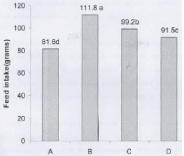
Figure 1: Effect of different treatment s on feed consumption during trial.
Treatments A, B, C and D stand for protein free ration, reference ration,
treated FM based and untreated FM based, respectively.
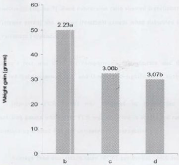
Figure 2: Effect of different treatments on weight gain during trial.
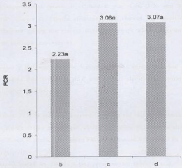
Figure 3: Effect of different treatments on FCR.

Figure 4: Effect of different treatments on per values.
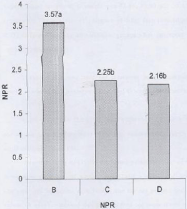
Figure 5: Effect of different treatments on NPR.
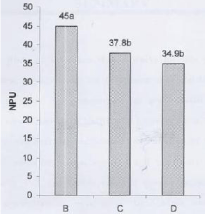
Figure 6: Comparison of treatment effects on NPU.
Where:
A= Protein free ration
B= Reference ration
C=Treated FM based
D= Untreated FM based
Feather meal is of great concern among scientists regarding its digestibility issues due to keratinous protein present in the feathers. However, processing makes it suitable to be included in the poultry diet. Its use was limited to only 3% due to low protein digestibility. However, studies also reported inclusion of feather meal up to 5% without any negative impact on feed intake [17-19]. Our results are in line with findings of Wang [20] and Caires [21] who also observed significant improvement in feed intake after inclusion of feather meal in the diet. Similarly, Mandubuike [18] reported a significant increase in feed intake on addition of feather meal in starter ration of broilers. The reason behind increased feed intake can be the broilers behavior of adjusting the protein and energy intake to fulfill their maintenance requirements. Furthermore, Deficiency of methionine in feather meal can also be the reason of improved feed intake to maintain a proper nutrient intake [22]. However, Ochitum [23] observed nonsignificant changes in feed intake among control and supplemented groups.
Body weight gain was non-significant (P>0.05) when comparing the ration without feather meal with ration having completely replaced fish meal [24]. Absence in weight gain improvement may be attributed due to the imbalance in amino acid profile in feather meal as lysine, tryptophan and methionine can be inherently deficient in the source [17,18,23]. Likewise Wang [20] also reported that substitution of fish meal with feather meal can be done up to 60% with non-significant (P›0.05) on live weight gain. Similarly, Tsang [25] investigated that after hydrolysis of feather meal using NaOH, it can be added up to 8% in broilers ration without any negative impact on weight gain. These results followed similar trend with findings of Mandubuike18 for substituting fish meal with 5% recommended inclusion in starter ration and Ahaotu and Ekenyem [24] who recommended 7.5% inclusion of feather meal in case of finisher ration without any negative impact on weight gain. Inspite of having improper amino acid profile, feather meal compensates this deficiency by having high-energy value and rich concentration of cysteine, arginine and threonine having prime importance in broiler diet [17].
The FCR results were non-significant among birds fed treated (Ration C) and untreated feather meal (Ration D). Results are in line with the findings of Ajayi and Iyayi [26] who found that feed conversion was non-significant when feather meal was offered to the birds. Feed utilization efficiency generally depends on energy level and dietary protein, as in feather meal, the protein quality is compensated by energy level [27] (Table 3). However, results are in contrast with the findings of Kirkpinar [28] who worked on the effect of inclusion of poultry by-product meal and enzyme prebiotic supplementation in grower diets on performance of broilers. Positive effect on feed conversion efficiency at 0 to 6 weeks was observed by poultry by-product meal supplemented with enzyme prebiotic. Moreover, Manzoor [29] also observed similar findings.
Nutrients
N-Free Ration (A)
Reference Ration (B)
Ration (D)
Ration (D)
ME Kcal/kg
3100
3100
3100
3100
CP%
0
10
10
10
Crude fat%
7.1
7.4
5
5
Crude fiber%
2
2
2
2
Ash%
1
1
6.83
1.21
Ca%
1.1
1
0.8
0.75
P%
0.35
0.40
0.43
0.46
Table 3: Nutrient composition of experimental rations.
Highest PER (4.46) was observed treatment B in which birds were fed with casein as the only source of nitrogen while non-significant difference was observed between C and D containing treated FM and untreated FM respectively. The results of this study are in agreement with the findings of Wang and Parson [30] who worked out the effect of processing systems on protein quality of feather meals and hog hair meal. Non-significant differences were observed between different processing systems. Similarly, Kim and Patterson [31] observed non-significant difference PER values between enzyme and sodium hydroxide treated feathers from dead hens then untreated feathers. But the results of present study contradicted with the study conducted by Kim [5] who observed significant difference between control and treated FM.
Highest NPR (3.57) value was observed for treatment B which contained casein as sole source of protein. On the other hand treatments C and D which contained NaOH treated FM and C-FM were not significantly difference from each other. Results of present study are contradictory with the findings of Kim and Patterson [31] (2000) on recycling dead hens by enzyme or sodium hydroxide pretreatment and fermentation. They reported that NPR of control group were significantly higher than that of enzyme treated or sodium hydroxide pretreatments.
Results for NPU had shown similar trend as observed by Hegedus [32] who observed non-significant effect of hydrolyzed FM and C-FM on NPU in broilers. Similarly, Barbour [33] compared the enzyme treated turkey by product meal with SBM and observed that protein sources had no effect on NPU.
Conclusion
It can be concluded that feather meal can be included in the broilers diet without any negative effect on its performance.
References
- Hasni MS, Sahito HA, Memon MA, Sanjrani MI, Gopang MA, Soomro NA. Effect of feeding various levels of feather meal as a replacement of fish meal on the growth of broiler. Int J Agric Innov Res. 2014; 3: 505-511.
- Adhikari BB, Chae M, Bressler DC. Utilization of slaughterhouse waste in value-added applications: Recent advances in the development of wood adhesives. Polymers. 2018; 10: 176.
- Sarmwatanakul A, Bamrongtum B. Aquarium fish nutrition. Extension paper No. 1/2000. Ornament Fish Research and Public Aquarium, Bangkok. 2000.
- El-Boushy AR, van der Poel AFB, Walraven OED. Feather meal-A biological waste: Its processing and utilization as a feedstuff for poultry. Animal Nutrition (Bulletin), Agric. University, Wageningen, the Netherlands. 2007.
- Kim WK, Lorenz ES, Patterson PH. Effect of enzymatic and chemical treatments on feather solubility and digestibility. Poult Sci. 2002; 81: 8195- 108.
- Al-Souti A, Gallardo W, Claereboudt M, Mahgoub O. Effects of autoclaving, addition of sodium hydroxide and their combination on protein content and in vitro digestibility of chicken feathers. Int J Poult Sci. 2018; 17: 356-361.
- Alam MJ, Howlider MAR, Pramanik and Haquem MAH. Effect of exogenous enzyme in diet on broiler performance. Int J Poult Sci. 2003; 2: 168-173.
- Wolber FM, Mc Grath M, Jackson F, Wylie K, Broomfield A. Cysteic acid in dietary keratin is metabolized to glutathione and liver taurine in a rat model of human digestion. Nutrients. 2016; 8: 104.
- Association of American Feed Control Officials. Official Publication. AAFCO, Inc., Atlanta, GA. 1994.
- Johnson ML, Parsons CM. Effects of raw material source, ash content and assay length on protein efficiency ratio and net protein values for animal protein meals. Poult Sci. 1997; 76: 1722-1727.
- Binkley CH, Vasak OR. A friable meal produced from feathers. Amer Egg Poultry Rev. 1951; 12: 68-72.
- Davis JG, Mecchi EP, Lineweaver H. Processing of poultry byproducts and their utilization in feeds. Part I. Processing of poultry by-products. Utilization Research Report No. 1961; 3: 1-21.
- Papadopoulos MC, EI-Boushy AR, Roodbeen AE. The effect of varying autoclaving conditions and added sodium hydroxide on amino acid content and nitrogen characteristics of feather meal. J Sci Food Agric. 1985; 36: 1219-1226.
- AOAC International. Official methods of analysis of AOAC International. 18th ed. AOAC International. Gaithersburg, MD. 1997.
- National Research Council. Nutrient Requirements of Poultry. 9th Rev. ed. Natl Acad Sci, Washington DC. 1994.
- Steel RGD, Torrie JH, Dicky DA. Principles and procedures of statistics- a biochemical approach. 3rd edition. McGraw Hill Book Co. Inc., New York, USA. 1996.
- Holanda MAC, Ludke M, Holanda JV, Rabello MCR, CBV Dutra WM, Vigoderis RB. Effect of feather meal in broiler chickens feed. Rev Bras De Anim. 2009; 10: 696-707.
- Mandubuike FN, Ekenyem BU, Ahaotu EO. Effect of dietary substitution of feather meal for fish meal on the performance of starter broilers. Anim Prod Res Adv. 2009; 5: 93-97.
- Xavier SAG, Stringini JH, de Brito AB, Andrade MA, Café MB, Leandro NSM. Feather and blood meal in pre-starter and starter diets for broilers. R Bras Zootec. 2011; 40: 1745-1752.
- Wang P, Yueying Z, Wang K, Guoshu Z, Chengrong M, Wushun H. Evaluation of acid hydrolyzed feather meal with chicken. J Huazhong Agric. 1990-2003. 1990.
- Caires CM, Fernandes EA, Fagundes NS, Carvalho AP, Maciel MP, Oliveira BR. The use of animal by-products in broiler feeds. Use of animal co-products in broilers diets. Rev Bras Cienc Avic. 2010; 12: 41-46.
- Nakhash RMS. The effects of partial replacement of soybean meal in the grower diet with sun dried blood and boiled feather meals on the performance of broiler chicks. Thesis for Master of Animal Production, Faculty of Graduate Studies, at An-Najah National University, Nablus, Palestine. 2008.
- Ochitum S. The effect of partial replacement of soyabean meal with broiled feather meal on the performance of broiler chickens. Afr J Ani Sci. 1993; 6: 597-600.
- Ahaotu OH, Ekenyem BU. Replacement value of feather meal for fish meal on performance of finisher broiler chicks. Int J Trop Agric and Food Sys. 2009; 3: 117-126.
- Tsang STL, Mc Kee EL, Andrews GP, Winslade EC, Steinhauser RL, Windsor HA. The utilization of hydrolyzed poultry feathers in iso-nitrogenous and isocaloric broiler rations. Poult Sci. 1963; 42: 1369-1672.
- Ajayi HI, Iyayi EA. Performance of broiler chickens fed hydrolysed feather meal. Proceedings of 5th International Poultry Summit, May 10-14, 2015, University of Ilorin, Ilorin, Kwara State, Nigeria. 2015; 1-5.
- Pesti GM. Impact of dietary amino acid and crude protein levels in broiler feeds on biological performance. J Appl Poul Res. 2009; 18: 477-486.
- Kirkpinar F, Acikgoz Z, Bozkur M, Ayhan V. The effects of inclusion of poultry by product meal and enzyme - prebiotic supplementation in grower diets on performance and feed digestibility of broilers. Br Poult Sci. 2004; 45: 273 -279.
- Manzoor MM. Graded replacement of fish meal with PBM in broiler rations supplemented by amino acids. MSc. thesis, Univ. of Agric., Faisalabad. 1993.
- Wang X, Parsons CM. Effect of processing systems on protein quality of feather meals and hog hair meals. Poult Sci. 1997; 76: 491- 496.
- Kim WK, Patterson PH. Nutritional value of enzyme- or sodium hydroxidetreated feathers from dead hens. Poult Sci. 2000; 79: 879-885.
- Hegedus M, Bokori J, Andrasofszky E, Kovari L. Optimizing protein quality of mixtures of blood meal, feat her meal and bone meal. Poult Sci. 1990; 38: 143-152.
- Barbour GM, Nemasetoni R, Lilburn MS, Werling M, Yersin AG. The effect of enzyme pre-digestion on the quality of poultry by-product meal from whole turkey mortality. Poult Sci. 1995; 74: 1180-1190.